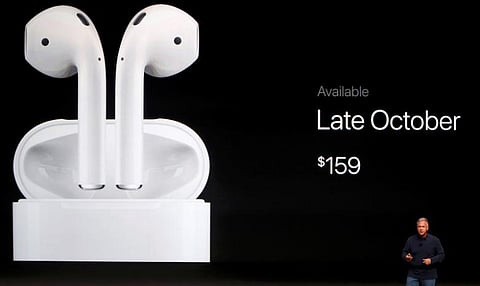Apple needs a mass strategy with wearables
For that, it needs the watch and AirPods to work just as well on other platforms

Seattle (Bloomberg): There are two key takeaways from the earnings that Apple Inc. reported — iPhones still matter, and wearables are big.
On the surface, it would appear that investors can bet on the continuing success of Apple Watch and the surging popularity of AirPods Pro to take up the slack left by declining iPhone revenue. From there, money from services including music, content and apps should just keep rolling in.
While it’s true that iPhone revenue climbed 8 per cent for the December quarter, its peak season, trailing 12-month revenue for the category is still down 6 per cent, proof that it takes more than one good quarter to turn things around. The wearables, home and accessories division stayed near 40 per cent growth over the past year.
That trajectory could put the category on course to overtake services, which were up 16 per cent, within two years. The narrative goes that as long as consumers continue to have iPhones in their pockets, then Apple will be able to keep selling accessories as well as services such as Apple TV+, apps and music.
And by making such compelling companion products, customers will necessarily turn to the iPhone when they next buy a handset.
Never a closed universe
Trying to keep customers hooked on the iPhone ecosystem by offering products that work only with Apple devices is flawed, though, and not backed by history.
We can go back almost two decades to see the folly of such an approach. When the iPod was first released in 2001, only those with Macs could use them. It wasn’t until a Windows version was released a year later that sales truly took off, with those customers quickly overtaking Mac users.
A similar tale unfolded for its companion service, the iTunes music store, which became available on Windows just six months after the Mac release.
Instead of using the success of the iPod to try shoehorn customers into buying Macs, which even then sold at a significant price premium to Windows PCs, executives knew at the time that the iPod could be a sales tool for its broader catalogue.
Fred Anderson, the chief financial officer at the time, encapsulated this strategy best in 2003 when he told investors, if “they love the experience of not only our music store, but our iPod, then they may the next time they decide to buy a second or third computer for their home, they may decide to buy Mac.”
Anderson was right. The Mac posted some of its best shipment and revenue growth in the years after the iPod and iTunes Store were made available for Windows. Furthermore, the fact that iPod shipments surpassed Mac shipments is a clear sign that a Mac-only approach would have capped sales of its comeback product.
Built on the iPod
If the iPod had never taken off, it’s doubtful Steve Jobs and Jony Ive would have been inspired to go further by creating the iPhone, or that customers would have been primed to buy such an expensive device. And so with that history lesson in mind, it’s time for Apple to untether its latest hit, the AirPods Pro, and its continuing success story, the Apple Watch.
In truth, AirPods can work with Android devices, but they lack full functionality, including customisable settings, audio sharing and the fit test because these require the companion app. The answer would be simple: Create an AirPods app for Android.
Apple TV+ is another example: It can work on a standard browser, but not very well and with a terrible mobile experience. Again, apps for other platforms could relieve this issue.
Then there’s the Apple Watch. In theory, users don’t need a phone at all, but Apple’s own website says that “Apple Watch Series 5 and Apple Watch Series 3 require an iPhone 6s or later with iOS 13 or later.”
Apple purists would argue that it’s precisely this tight integration with the iPhone that makes wearables such as Apple Watch and AirPods such valuable products. That’s true, but capping your potential audience to just 15 per cent of the global smartphone market is a pretty shortsighted way of making the point especially when there’s so much revenue to be had from non-hardware services.
And it’s also why Apple should cast off the shackles and let the other 85 per cent of the smartphone market discover the magic of Apple’s ecosystem for themselves.
Sign up for the Daily Briefing
Get the latest news and updates straight to your inbox



